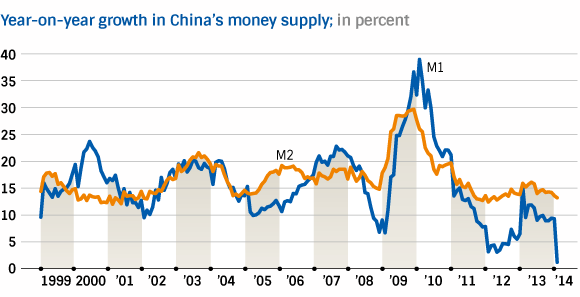Money Supply and Lending Growth Decline Sharply
Both the growth rate of China’s narrow M1 money supply and the broader M2 measure have recently declined to levels not seen in many years. Here is a recent chart showing both:

Annualized growth in China’s narrow money measure M1 (currency and sight deposits) has collapsed to just 1.5%, a level not seen in at least the past 15 years (and probably a good while longer). M2, which includes savings deposits, corporate time deposits, deposits in trusts and a few other smaller items grew at 13.2% year-on-year, but even that is one of the lowest growth rates of the past decade – click to enlarge.
We’re not 100% sure if China’s M1 is a good proxy for money TMS, as there is a paucity of readily available monetary data from the PBoC (its web site is basically useless, at least it was when we last looked) and we don’t know whether savings deposits are available on demand in China or not, but it is a fairly good bet that it actually is at the very least a good proxy for TMS-1.
As such we would expect it to be more volatile, which it indeed is. As you can see, its growth rate has peaked at nearly 39% year-on-year in the post Lehman push by the Chinese authorities, when they took steps to reliquefy the system by ordering China’s banks to lend as much as possible to all comers. It’s a good thing we have fiat money and these central planners everywhere, as that sure lowers the monetary system’s volatility a lot! Steady as she goes!
Looking at M1 in absolute numbers, we can see that the sharp drop-off in the annualized growth rate was the result of a very big monthly contraction in M1 early this year. This suggests the authorities are deliberately stepping on the brakes, or are at least not trying to counter a case of private sector loan contraction.

China’s M1 money supply in absolute numbers. There have been several instances of month-on-month contractions, but the most recent one was unusually large – click to enlarge.

